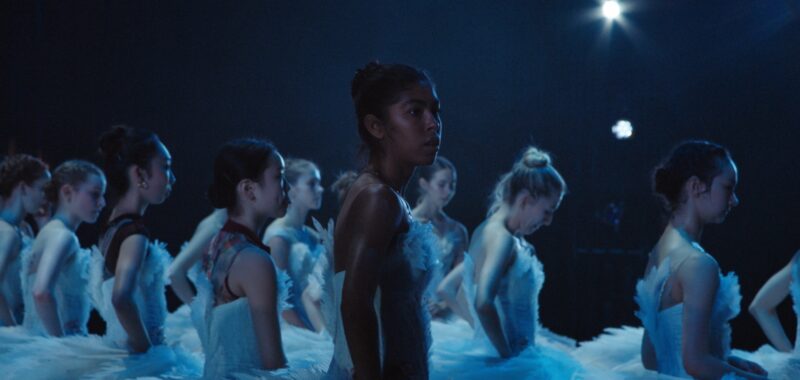Fleeting minutes before the debut of their show, ballerinas line their eyelids, glue on lashes, polish pointe shoes. They are lithe, serious, preternaturally poised. It could be any opening night of Swan Lake, Tchaikovsky’s masterpiece that, despite its ho-hum 1877 reception, has become the most famous ballet of all time — hailed for its vision of fragile feminine beauty and the myth of purity that flutters in its wake.
But this time the myth crumples like an elegant bird after a moonlit arabesque. “We’re gonna be really fucking good,” quips a raven-haired dancer to the choreographer wishing them luck. A rainbow flag reflects from her mirror, in front of which a coffee mug reads, “Beneath all the tattoos, you’re still a mainstream cunt.”
Check your ticket (and expectations) for Swan Song, Chelsea McMullan and Sean O’Neill’s bracing tour-de-force documentary that pulls back the curtains on contemporary ballet. On one level, the film pays tribute to ballet icon Karen Kain’s last hurrah before she retires as Artistic Director of the National Ballet of Canada, yet on a deeper, more profound level, Swan Song sings to the experience of the corps — the body of dancers onstage whose synchronicity and homogeneity tend to render them anonymous and forgotten.

In this film they are, rather, the most cogent characters — a motley team of young women as numinous as they are numerous, as self-aware and funny as they are disciplined and resilient. Among them, we get to know Tene Ward, a Black dancer from Australia whose mother warned her that “it is going to be harder for you” to get ahead; Arielle Miralles, who jests about the impossibility of dating an unstylish guy; and, no doubt the company’s enfant terrible, Shaelynn Estrada, a queer, half-Mexican “Army brat” whose mother worked as a receptionist at her Bible Belt studio to pay for classes.
“It’s hard to have a personality in direct conflict with the thing you love most in the world,” she explains, drolly showing off her quartet of bracelets that read “Socialist Marxist Libertarian Slut.” During one of the film’s most stunning scenes, Shae performs alone in a pool with no water, her toe shoes grazing the mildewed antique tile. “Ballet is the only thing that helps me,” she shares. “It’s like my angel, but also my fucking demon … I love ballet but sometimes it feels like it doesn’t love me back.”
This sense of tension ripples through matters of race, class, and gender. “The world of ballet is having a very slow reckoning with its deep, long problem of racism,” explains dance scholar Seika Boye, one of a few talking heads to surface briefly in a film dominated by movement. Breaking with classical tradition, Kain decides that the corps will dance in their bare legs, so that their humanity and individuality as women are more visually palpable. But tossing the tights doesn’t fix everything; some dancers complain of legs slippery with sweat, while others, like Estrada, prefer them precisely for their ability to conceal. “We have to be very clear that this is Karen’s decision,” says choreographer Robert Binet during a staff meeting. “Nobody gets to say, ‘I want to wear tights,’ ‘I don’t want to wear tights.’” Clearly, autonomy for the corps has its limits.

Jurgita Dronina is the star of the stage production, and epitomizes grace under pressure. Raised in poverty during the tumult of the Soviet Union’s rapid collapse, the 38-year-old principal dancer prepares for her 11th turn as the Swan Queen while battling a debilitating nerve injury. “I don’t talk about this injury,” she says, barbell squatting at the gym after dropping her two sons off at sports practice. “I don’t think my colleagues even know. I just deal with it every single day.”
Unlike many ballet narratives — or, indeed, the narratives that dominate the art — Swan Song has no villains. The closest we get to one is ballet itself: at once demanding, debilitating, and extraordinarily exhilarating, a polarizing art if ever there was one.
“The ‘feminine’ woman is forever static and childlike,” argued feminist Susan Faludi almost 35 years ago. “She is like the ballerina in an old-fashioned music box, her unchanging features tiny and girlish, her voice tinkly, her body stuck on a pin, rotating in a spiral that will never grow.” Indeed, a visual motif in Swan Song is a plastic dancer spinning slowly in a jewelry box. But it’s played for ironic effect — the dancers we grow to know (and love) are sweating, swearing, soaring women, entirely at odds with conceptions of purity and frailness. Their supreme effort to float seemingly with ease is fraught with the cultural connotations of “femininity” in general.
“Ballet is fucking punk rock,” says Estrada. And by the end of Swan Song, we believe her.

Swan Song is currently in select theaters and is available to purchase on various streaming services.

